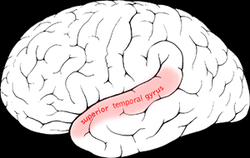Superior temporal gyrus
| Superior temporal gyrus | |
|---|---|
 Superior temporal gyrus of the human brain. | |
 Drawing of a cast to illustrate the relations of the brain to the skull. (Superior temporal gyrus labeled at center, in green section.) | |
| Details | |
| Part of | Temporal lobe |
| Artery | middle cerebral |
| Identifiers | |
| Latin | gyrus temporalis superior |
| NeuroNames | 136 |
| NeuroLex ID | birnlex_1648 |
| TA98 | A14.1.09.138 |
| TA2 | 5489 |
| FMA | 61905 |
| Anatomical terms of neuroanatomy | |
The superior temporal gyrus is one of three (sometimes two) gyri in the temporal lobe of the human brain, which is located laterally to the head, situated somewhat above the external ear.
The superior temporal gyrus is bounded by:
- the lateral sulcus above;
- the superior temporal sulcus (not always present or visible) below;
- an imaginary line drawn from the preoccipital notch to the lateral sulcus posteriorly.
The superior temporal gyrus contains several important structures of the brain, including:
- Brodmann areas 41 and 42, marking the location of the primary auditory cortex, the cortical region responsible for the sensation of sound;
- Wernicke's area, Brodmann 22p, an important region for the processing of speech so that it can be understood as language.
The superior temporal gyrus contains the primary auditory cortex, which is responsible for processing sounds. Specific sound frequencies map precisely onto the primary auditory cortex. This auditory (or tonotopic) map is similar to the homunculus map of the primary motor cortex. Some areas of the superior temporal gyrus are specialized for processing combinations of frequencies, and other areas are specialized for processing changes in amplitude or frequency. The superior temporal gyrus also includes the Wernicke's area, which (in most people) is located in the left hemisphere. It is the major area involved in the comprehension of language. The superior temporal gyrus (STG) is involved in auditory processing, including language, but also has been implicated as a critical structure in social cognition. [1])
Function
The superior temporal gyrus has been involved in the perception of emotions in facial stimuli.[2] [3])
Additional images
-
Lateral view of a human brain, main gyri labeled.
References
- ^ Erin D. Bigler, Sherstin Mortensen, E. Shannon Neeley, Sally Ozonoff, Lori Krasny, Michael Johnson, Jeffrey Lu, Sherri L. Provencal, William McMahon & Janet E. Lainhart (2007): Superior Temporal Gyrus, Language Function, and Autism, Developmental Neuropsychology, 31:2, 217-238
- ^ Radua, Joaquim; Phillips, Mary L.; Russell, Tamara; Lawrence, Natalia; Marshall, Nicolette; Kalidindi, Sridevi; El-Hage, Wissam; McDonald, Colm; Giampietro, Vincent; Brammer, Michael J.; David, Anthony S.; Surguladze, Simon A. (2010). "Neural response to specific components of fearful faces in healthy and schizophrenic adults". NeuroImage. 49: 939–946. doi:10.1016/j.neuroimage.2009.08.030. PMID 19699306.
- ^ Erin D. Bigler, Sherstin Mortensen, E. Shannon Neeley, Sally Ozonoff, Lori Krasny, Michael Johnson, Jeffrey Lu, Sherri L. Provencal, William McMahon & Janet E. Lainhart (2007): Superior Temporal Gyrus, Language Function, and Autism, Developmental Neuropsychology, 31:2, 217-238
[1] Erin D. Bigler, Sherstin Mortensen, E. Shannon Neeley, Sally Ozonoff, Lori Krasny, Michael Johnson, Jeffrey Lu, Sherri L. Provencal, William McMahon & Janet E. Lainhart (2007): Superior Temporal Gyrus, Language Function, and Autism, Developmental Neuropsychology, 31:2, 217-238

